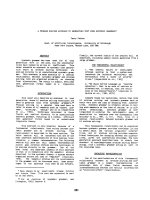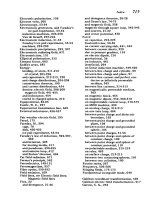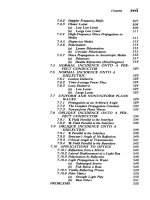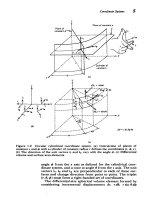Managerial economics a problem solving approach
Bạn đang xem bản rút gọn của tài liệu. Xem và tải ngay bản đầy đủ của tài liệu tại đây (4.28 MB, 557 trang )
This page intentionally left blank
Managerial Economics
Managerial economics, meaning the application of economic methods in the managerial decision-making process, is a fundamental part of any business or management course. This textbook covers all the main aspects of managerial economics: the
theory of the firm; demand theory and estimation; production and cost theory and
estimation; market structure and pricing; game theory; investment analysis and
government policy. It includes numerous and extensive case studies, as well as
review questions and problem-solving sections at the end of each chapter. Nick
Wilkinson adopts a user-friendly problem-solving approach which takes the reader
in gradual steps from simple problems through increasingly difficult material to
complex case studies, providing an understanding of how the relevant principles can
be applied to real-life situations involving managerial decision-making. This book
will be invaluable to business and economics students at both undergraduate and
graduate levels who have a basic training in calculus and quantitative methods.
N I C K W I L K I N S O N is Associate Professor in Economics at Richmond, The American
International University in London. He has taught business and economics in various
international institutions in the UK and USA, as well as working in business management in both countries.
Cambridge, New York, Melbourne, Madrid, Cape Town, Singapore, São Paulo
Cambridge University Press
The Edinburgh Building, Cambridge , UK
Published in the United States of America by Cambridge University Press, New York
www.cambridge.org
Information on this title: www.cambridge.org/9780521819930
© Nick Wilkinson 2005
This book is in copyright. Subject to statutory exception and to the provision of
relevant collective licensing agreements, no reproduction of any part may take place
without the written permission of Cambridge University Press.
First published in print format 2005
-
-
---- eBook (EBL)
--- eBook (EBL)
-
-
---- hardback
--- hardback
-
-
---- paperback
--- paperback
Cambridge University Press has no responsibility for the persistence or accuracy of
s for external or third-party internet websites referred to in this book, and does not
guarantee that any content on such websites is, or will remain, accurate or appropriate.
Contents
Preface page vii
Acknowledgements x
Detailed contents xi
PART I INTRODUCTION
1
Chapter 1 Nature, scope and methods of managerial economics 3
Chapter 2 The theory of the firm 20
PART II DEMAND ANALYSIS
71
Chapter 3 Demand theory 73
Chapter 4 Demand estimation
122
PART III PRODUCTION AND COST ANALYSIS
Chapter 5 Production theory
173
175
Chapter 6 Cost theory 212
Chapter 7 Cost estimation
254
PART IV STRATEGY ANALYSIS
285
Chapter 8 Market structure and pricing
287
Chapter 9 Game theory 331
Chapter 10 Pricing strategy
382
Chapter 11 Investment analysis 430
Chapter 12 Government and managerial policy 469
Index 522
v
Managerial Economics
A Problem-Solving Approach
Nick Wilkinson
Preface
Managerial economics, meaning the application of economic methods to the
managerial decision-making process, is a fundamental part of any business or
management course. It has been receiving more attention in business as
managers become more aware of its potential as an aid to decision-making,
and this potential is increasing all the time. This is happening for several
reasons:
1 It is becoming more important for managers to make good decisions and to
justify them, as their accountability either to senior management or to
shareholders increases.
2 As the number and size of multinationals increases, the costs and benefits at
stake in the decision-making process are also increasing.
3 In the age of plentiful data it is more imperative to use quantitative and
rationally based methods, rather than ‘intuition’.
4 The pace of technological development is increasing with the impact of the
‘new economy’. Although the exact nature of this impact is controversial,
there is no doubt that there is an increased need for economic analysis
because of the greater uncertainty and the need to evaluate it.
5 Improved technology has also made it possible to develop more sophisticated methods of data analysis involving statistical techniques. Modern
computers are adept at ‘number-crunching’, and this is a considerable
aid to decision-making that was not available to most firms until recent
years.
As managerial economics has increased in importance, so books on the subject
have proliferated. Many of the more recent ones claim like this one to take a
problem-solving approach. I have found from my own teaching experience
that, in spite of this, students of the subject tend to have two main problems:
1 They claim to understand the theory, but fail to see how to put principles
into practice when faced with the kind of problems they find in the textbooks, even though these are considerably simplified compared with reallife situations.
2 They fail to see the relevance of the techniques presented in the books in
terms of application to real-life situations.
The two problems are clearly related. Textbook problems are simplified, in
terms of the amount of data and decision variables, to make them easier for
vii
viii
PREFACE
students to analyse. However, the result of this is that the textbook problems
tend to fall between two stools: they are still too difficult in some cases for
students to tackle without considerable help (the first problem), yet they are
too simplified and abstract for students to see how textbook methods can be
applied to real-life situations (the second problem).
This book attempts to overcome the considerable obstacles above. It adopts
a user-friendly problem-solving approach, which takes the reader in gradual
steps from easy, very simplified problems through increasingly difficult material to complex case studies.
Pedagogical features
1 The objectives of each chapter are clearly stated at the start of the chapter.
2 Case studies are plentiful and have been carefully selected. These are
designed to be global in their application and relevance, and of recent
origin. They are sometimes longer than the typical case study in textbooks
in order to achieve a fuller flavour of real life, and they concentrate on the
managerial decision-making aspect. The cases are also integrated with the
material in the text, not just in terms of relevance, but also in terms of
asking specific questions, often of a quantitative nature.
3 Examples are given throughout the text of firms or situations, to illustrate
principles and their real-life application; an effort is made to use examples
to which students can easily relate from their own experience.
4 There is an emphasis on the interdisciplinary aspects of managerial economics; problems are addressed in all the main functional areas of marketing, finance, production and human resources.
5 Quantitative techniques are introduced only where they are relevant to the
material discussed, and are then applied in that context. This is contrary to
the common treatment, where many techniques are explained in the early
part of textbooks, before the relevant economic theory. Teaching experience suggests that students comprehend the techniques more easily if they
can immediately see their application. It is assumed in the text that students already have a basic knowledge of calculus and statistics.
6 Key terms and concepts are written in bold; the definitions and interpretations of these terms and concepts are written in bold italics.
7 Many chapters include a section titled ‘A problem-solving approach’ at the
end of the chapter, in order to bridge the gap described above as the first
student problem. These sections include several solved problems, with the
rationale for the methodology explained as well as the calculations.
8 Summaries are provided at the end of each chapter of the key points.
9 Review questions are included at the end of each chapter for students to
test their understanding of the material.
10 Problems of a quantitative nature are also included at the end of chapters.
These can be used by both students and instructors, as test questions or
assignments.
Preface
11 Starred material is included which indicates a greater degree of difficulty;
this is more suitable for MBA students, and can be omitted without causing
problems with understanding the remaining material. Sometimes the
starred material relates to whole sections, sometimes to subsections, and
sometimes just to particular headings.
12 Throughout the book there is an effort to tie economic theory and practice
together. Students should be able to see how empirical studies are conducted and the role of these in testing theories; the relevance of this process
to managerial decision-making is emphasized.
Structure and content
The text is structured into parts, chapters, sections, subsections, headings and
subheadings. The first four are self-explanatory; headings are titled alphabetically, while subheadings are titled numerically. An attempt is made to ensure
both consistency of treatment and clarity of exposition, so that students can
easily see how the various materials are related.
Part I of the text is an overview of the subject matter, and is particularly
concerned with the methodology employed and the objectives of firms and
managers. Part II is concerned with examining demand analysis. This involves
a discussion of consumer theory, the theoretical principles of demand and the
empirical aspects of demand estimation. Considerable attention is given to
examining statistical techniques of estimation, much more than in the typical
text. This is because of the increasing importance of the use of these techniques and the ubiquity of software packages for data analysis. Part III examines
production theory and costs; the treatment is similar to the previous part, in
that the principles of production and costs are discussed, and then the empirical and statistical aspects of estimation are explained. Part IV examines strategy analysis; this covers market structure, pricing, game theory, investment
analysis and the impact of government policy on managerial decision-making.
The coverage here is broader than a typical text, and there is particular
emphasis on the consideration of non-price decisions and interdependent
decision-making.
In each chapter there are three or four case studies, with questions attached.
These are inserted into the text as close as possible to their points of relevance.
Many chapters also include solved problems; sometimes these are embodied in
the text as examples to illustrate the concepts involved, and in other cases they
are included at the end of the chapter, according to whatever seems more
appropriate. There are also review questions and in many cases additional
problems at the end of the chapters, following the chapter summaries. The
currency units involved in these problems vary, being mainly in pounds sterling and US dollars; this is in keeping with the international nature of the
material in both the text and the case studies.
ix
Acknowledgements
This text grew out of lecture material that I have developed while teaching
courses at both undergraduate and graduate level, mainly but not entirely in
managerial economics, over more than twenty years. During that time I have
had many excellent students in my classes, who have enabled me to understand more clearly the requirements for a text of this type. Their comments
and questions have contributed significantly to the style and form of the book.
Other students have also contributed, in that their questions and problems
have over the years led to certain methods of presentation and exposition
which have, I hope, improved both the clarity and relevance of the material.
I am grateful to the anonymous referees for various pieces of constructive
advice regarding structure and content. In particular I would like to thank John
Mark of King’s College London for his advice and encouragement. Finally,
I would like to thank Yasmin, my wife, for her unending patience and support.
The majority of the material in the text has been class-tested, but I am sure
that there is still scope for improvement in terms of both content and clarity of
exposition. Constructive suggestions in these areas are certainly welcome.
x
Detailed contents
PART I INTRODUCTION
page
1
Chapter 1 Nature, scope and methods of managerial economics
1.1 Introduction 4
Case study 1.1: Global warming 4
1.2 Definition and relationships with other disciplines 7
Definition 7
Relationship with economic theory 8
Relationship with decision sciences 10
Relationship with business functions 10
1.3 Elements of managerial economics 11
Subject areas and relationships 11
Presentation of topics 11
1.4 Methods 12
Scientific theories 12
Learning economics 14
Case study 1.2: Import quotas on Japanese cars 15
Tools of analysis: demand and supply 16
Case study 1.3: Equal prize money in tennis 17
Summary 18
Review questions 19
Notes 19
3
Chapter 2 The theory of the firm 20
2.1 Introduction 22
2.2 The nature of the firm 23
Economic organizations 23
Transaction cost theory 25
Motivation theory 26
Property rights theory 29
2.3 The basic profit-maximizing model 32
Assumptions 32
Limitations 35
Usefulness 35
2.4 The agency problem 36
Contracts and bounded rationality 37
xi
xii
DETAILED CONTENTS
Hidden information 38
Hidden action 39
Control measures 40
Limitations of the agency model 43
Case study 2.1: Corporate governance 44
2.5 Measurement of profit 48
Nature of measurement problems 48
Efficient markets hypothesis* 50
Limitations of the EMH* 51
Case study 2.2: Enron 53
2.6 Risk and uncertainty 57
Attitudes to risk 58
Risk and objectives 58
Risk and the agency problem 59
2.7 Multiproduct strategies 60
Product line profit maximization 60
Product mix profit maximization 61
Case study 2.3: PC World 62
2.8 Conclusion 62
The public sector and non-profit organizations 63
Satisficing 63
Surveys of business objectives 64
Ethics 64
Profit maximization revisited 65
Summary 66
Review questions 67
Notes 68
PART II DEMAND ANALYSIS
71
Chapter 3 Demand theory 73
3.1 Introduction 74
3.2 Definition and representation 74
Meaning of demand 74
Tables, graphs and equations 75
Interpretation of equations 78
3.3 Consumer theory 80
Assumptions 81
Analysis 83
Limitations 88
Alternative approaches* 88
Conclusions 90
3.4 Factors determining demand 91
Controllable factors 92
Detailed contents
Uncontrollable factors 93
Demand and quantity demanded 96
Case study 3.1: Marks & Spencer 97
3.5 Elasticity 98
Price elasticity 99
Promotional elasticity 105
Income elasticity 107
Cross-elasticity 108
3.6 A problem-solving approach 110
Examples of solved problems 110
Case study 3.2: The Oresund bridge 115
Case study 3.3: The Texas state bird 116
Case study 3.4: Oil production 116
Summary 118
Review questions 118
Problems 119
Notes 120
Chapter 4 Demand estimation 122
4.1 Introduction 124
4.2 Methods 125
Consumer surveys 125
Market experiments 126
Statistical methods 127
4.3 Model specification 127
Mathematical models 127
Statistical models 129
4.4 Data collection 129
Types of data 129
Sources of data 130
Presentation of data 131
4.5 Simple regression 133
The OLS method 133
Application of OLS 133
4.6 Goodness of fit 135
Correlation 135
The coefficient of determination
4.7 Power regression 137
Nature of the model 138
Application of the model 138
4.8 Forecasting 139
Nature 139
Application 139
4.9 Multiple regression 140
Nature of the model 140
136
xiii
xiv
DETAILED CONTENTS
Advantages of multiple regression 141
Dummy variables* 142
Mathematical forms* 143
Interpretation of the model results* 144
Selecting the best model* 148
Case study 4.1: The demand for coffee 149
4.10 Implications of empirical studies 150
The price–quality relationship 150
Lack of importance of price 150
Dynamic relationships 151
4.11 A problem-solving approach 151
Examples of solved problems 152
Case study 4.2: Determinants of car prices 155
Case study 4.3: The Sports Connection* 155
Appendix A: Statistical inference* 157
Nature of inference in the OLS model 157
Assumptions 157
Calculations for statistical inference 159
Consequences of assumptions 160
Estimation 162
Hypothesis testing 162
Confidence intervals for forecasts 163
Appendix B: Problems of the OLS model* 165
Specification error 165
The identification problem 165
Violation of assumptions regarding the error term 166
Multicollinearity 168
Summary 169
Review questions 169
Problems 170
Notes 171
PART III PRODUCTION AND COST ANALYSIS
Chapter 5 Production theory 175
5.1 Introduction 176
5.2 Basic terms and definitions 177
Factors of production 177
Production functions 178
Fixed factors 179
Variable factors 179
The short run 180
The long run 180
Scale 180
175
Detailed contents
Efficiency 181
Input-output tables 181
5.3 The short run 182
Production functions and marginal product 182
Derivation of the short-run input-output table 183
Increasing and diminishing returns 185
Relationships between total, marginal and average
product 186
Determining the optimal use of the variable input 188
Case study 5.1: Microsoft – increasing or diminishing
returns? 191
Case study 5.2: State spending 192
5.4 The long run 193
Isoquants 193
The marginal rate of technical substitution 194
Returns to scale 194
Determining the optimal combination of inputs 198
5.5 A problem-solving approach 203
Planning 203
Marginal analysis 203
Example of a solved problem 204
Evaluating trade-offs 205
Example of a solved problem 206
Case study 5.3: Factor Substitution in the National Health
Service 207
Summary 208
Review questions 209
Problems 210
Notes 211
Chapter 6 Cost theory 212
6.1 Introduction 213
Importance of costs for decision-making 213
Explicit and implicit costs 214
Historical and current costs 214
Sunk and incremental costs 215
Private and social costs 215
Relevant costs for decision-making 216
Case study 6.1: Brewster Roofing 216
Summary of cost concepts 216
6.2 Short-run cost behaviour 217
Classification of costs 217
Types of unit cost 217
Derivation of cost functions from production
functions 218
xv
xvi
DETAILED CONTENTS
Factors determining relationships with output 220
Efficiency 223
Changes in input prices 223
Different forms of cost function 223
6.3 Long-run cost behaviour 226
Derivation of cost functions from production
functions* 226
Economies of scale 227
Diseconomies of scale 229
Economies of scope 230
Relationships between short- and long-run cost
curves 231
Strategy implications 234
6.4 The learning curve 235
6.5 Cost–volume–profit analysis 236
Purpose and assumptions 236
Break-even output 238
Profit contribution 238
Operating leverage* 239
Limitations of CVP analysis 239
6.6 A problem-solving approach 240
Examples of solved problems 241
Case study 6.2: Converting to LPG – is it worth it? 245
Case study 6.3: Rescuing Nissan 245
Case study 6.4: Earls Court Gym 246
Summary 250
Review questions 250
Problems 251
Notes 253
Chapter 7 Cost estimation 254
7.1 Introduction 255
Importance of cost estimation for decision-making 255
Types of cost scenario 256
Methodology 256
7.2 Short-run cost estimation 259
Types of empirical study 260
Problems in short-run cost estimation 260
Different forms of cost function, interpretation and
selection 263
Implications of empirical studies 265
7.3 Long-run cost estimation 265
Types of empirical study 266
Problems in long-run cost estimation 266
Different forms of cost function 268
Detailed contents
Implications of empirical studies 268
Case study 7.1: Banking 270
7.4 The learning curve 271
Types of specification 271
Case study 7.2: Airlines 272
Case study 7.3: Electricity generation 273
Application of the learning curve 275
Example of a solved problem 275
Implications of empirical studies 276
7.5 A problem-solving approach 277
Examples of solved problems 278
Summary 280
Review questions 280
Problems 281
Notes 282
PART IV: STRATEGY ANALYSIS
285
Chapter 8 Market structure and pricing 287
8.1 Introduction 288
Characteristics of markets 289
Types of market structure 289
Relationships between structure, conduct and
performance 290
Methodology 291
8.2 Perfect competition 291
Conditions 291
Demand and supply 292
Graphical analysis of equilibrium 293
Algebraic analysis of equilibrium 296
Adjustment to changes in demand 297
8.3 Monopoly 300
Conditions 300
Barriers to entry and exit 300
Graphical analysis of equilibrium 304
Algebraic analysis of equilibrium 305
Pricing and price elasticity of demand 306
Comparison of monopoly with perfect competition 309
Case study 8.1: Electricity generation 311
8.4 Monopolistic competition 313
Conditions 313
Graphical analysis of equilibrium 313
Algebraic analysis of equilibrium 314
Comparison with perfect competition and monopoly 316
xvii
xviii
DETAILED CONTENTS
Comparison with oligopoly 316
Case study 8.2: Price cuts for medicines 317
8.5 Oligopoly 318
Conditions 318
The kinked demand curve model 319
Collusion and cartels 321
Price leadership 324
Case study 8.3: Mobile phone networks 324
Case study 8.4: Private school fees 325
8.6 A problem-solving approach 327
Summary 328
Review questions 328
Problems 329
Notes 330
Chapter 9 Game theory 331
9.1 Introduction 332
Nature and scope of game theory 333
Elements of a game 333
Types of game 336
9.2 Static games 338
Equilibrium 338
Oligopoly models 340
Property rights* 349
Nash bargaining 351
Case study 9.1: Experiments testing the Cournot
equilibrium 352
9.3 Dynamic games 353
Equilibrium 353
Strategic moves and commitment 355
Stackelberg oligopoly 358
Case study 9.2: Monetary policy in Thailand 361
9.4 Games with uncertain outcomes* 361
Mixed strategies 362
Moral hazard and pay incentives 365
Moral hazard and efficiency wages 367
9.5 Repeated games* 370
Infinitely repeated games 370
Finitely repeated games 375
9.6 Limitations of game theory 375
Case study 9.3: Credible commitments 376
9.7 A problem-solving approach 378
Summary 378
Review questions 379
Problems 379
Notes 380
Detailed contents
Chapter 10 Pricing strategy 382
10.1 Introduction 384
10.2 Competitive advantage 385
Nature of competitive advantage 385
Value creation 385
Case study 10.1: Mobile phones – Nokia 388
10.3 Market positioning, segmentation and targeting 389
Cost advantage 390
Benefit advantage 390
Competitive advantage, price elasticity and pricing
strategy 391
Segmentation and targeting 392
Role of pricing in managerial decision-making 394
Case study 10.2: Handheld Computers – Palm 394
10.4 Price discrimination 396
Definition and conditions 396
Types of price discrimination 397
Price discrimination in the European Union 399
Analysis 401
Example of a solved problem 401
Case study 10.3: Airlines 403
10.5 Multiproduct pricing 405
Context 405
Demand interrelationships 406
Production interrelationships 407
Joint products 407
Example of a solved problem 408
10.6 Transfer pricing 411
Context 411
Products with no external market 412
Example of a solved problem 412
Products with perfectly competitive external
markets 415
Products with imperfectly competitive external
markets 415
10.7 Pricing and the marketing mix* 416
An approach to marketing mix optimization 416
The constant elasticity model 417
Complex marketing mix interactions 420
10.8 Dynamic aspects of pricing 421
Significance of the product life-cycle 421
Early stages of the product life-cycle 421
Later stages of the product life-cycle 422
10.9 Other pricing strategies 422
Perceived quality 423
Perceived price 423
xix
xx
DETAILED CONTENTS
The price–quality relationship
Perceived value 424
Summary 424
Review questions 426
Problems 426
Notes 428
423
Chapter 11 Investment analysis 430
11.1 Introduction 431
The nature and significance of capital budgeting 431
Types of capital expenditure 432
A simple model of the capital budgeting process 434
11.2 Cash flow analysis 434
Identification of cash flows 435
Measurement of cash flows 435
Example of a solved problem 435
Case study 11.1: Investing in a corporate fitness
programme 439
11.3 Risk analysis 439
Nature of risk in capital budgeting 439
Measurement of risk 440
11.4 Cost of capital 445
Nature and components 445
Cost of debt 446
Cost of equity 447
Weighted average cost of capital 449
11.5 Evaluation criteria 450
Net present value 450
Internal rate of return 451
Comparison of net present value and internal rate of
return 452
Other criteria 452
Decision-making under risk 454
Example of a solved problem 455
Decision-making under uncertainty 458
11.6 The optimal capital budget 459
The investment opportunity (IO) schedule 460
The marginal cost of capital (MCC) schedule 460
Equilibrium of IO and MCC 462
11.7 A problem-solving approach 462
Case study 11.2: Under-investment in transportation
infrastructure 462
Case study 11.3: Over-investment in fibre optics 463
Summary 465
Review questions 466
Detailed contents
Problems 466
Notes 468
Chapter 12 Government and managerial policy 469
12.1 Introduction 471
Importance of government policy 471
Objectives of government policy 471
12.2 Market failure 473
Definition and types 473
Monopolies 474
Externalities 475
Public goods 475
Imperfect information 476
Transaction costs 476
12.3 Monopoly and Competition Policy 477
Basis of government policy 477
The structure–conduct–performance (SCP) model 479
Detection of monopoly 480
Public ownership 481
Privatization and regulation 486
Promoting competition 490
Restrictive practices 493
Case study 12.1: Electricity 499
Case study 12.2: Postal services 503
12.4 Externalities 507
Optimality with externalities 508
Implications for government policy 509
Implications for management 511
Case study 12.3: Fuel taxes and optimality 512
12.5 Imperfect information 513
Incomplete information 514
Asymmetric information 514
Implications for government policy 516
Implications for management 518
Summary 518
Review questions 520
Notes 520
Index 522
xxi
PART I
INTRODUCTION
Part I (Chapters 1 and 2) examines the nature,
scope and methods of managerial economics and
the theory of the firm. Chapter 1 is therefore concerned with explaining why managerial economics is important and useful as an area of study, how
it relates to other disciplines, what its core areas
are, and the methods of analysis which it uses.
Chapter 2 examines the basic profit-maximizing
model of behaviour, and its underlying assumptions, and then proceeds to relax these assumptions to develop a more complex but realistic
model of firms’ behaviour. The focus is on the
individual and the nature of transactions, with
an emphasis on agency theory. These two chapters
introduce the framework of parameters and analysis that are developed throughout the remainder
of the text.









